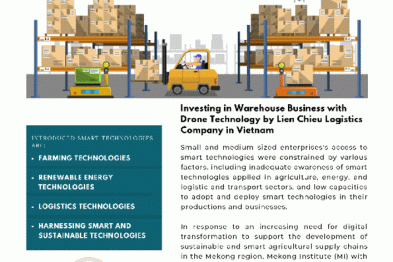
GMS Articles
Investing in Warehouse Business with Drone Technology by Lien Chieu Logistics Company in Vietnam Small and medium-sized enterprises access to smart technologies was constrained by various factors. including inadequate awareness of smart technologies applied in agriculture, and energy. and logistic and transport sectors, and low capacities to adopt and deploy smart technologies in their productions …
We would like to express our utmost appreciation to all the 41 participants from the Lancang-Mekong(LM) countries, i.e. Cambodia, P.R. China, Lao PDR, Myanmar, Thailand, and Vietnam forparticipating in the Online Modular Training on “Facilitating Cross-Border Electronic Transactionsand Electronic Signature”. The participants engaged in the activities of the training course, whichincluded live contact sessions, live …
FACILITATING CROSS-BORDER ELECTRONIC TRANSACTIONS AND THE USE OF ELECTRONIC SIGNATURES Read More »
Beginning in 2020, Mekong Institute (MI) and the New Zealand Aid Program (NZAP) launched a series of hybrid PROSAFE forums in Cambodia, Lao PDR, Myanmar, and Vietnam to come out with a cohesive multi-sectoral approach that will scale up the competitiveness and resiliency of the agri-food industry against a pandemic climate. In this feature, MI …
As the most influential and devastating “black swan event” the COVID-19 outbreak on an international scale has stricken almost every country in the world so severely. Faced with this unprecedented challenge, China has rallied support from the entire nation, fully utilized the latest technologies, and exerted coordination of people from all walks of life. China …
STUDY ON CHINA’S WAY OF UTILIZATION OF TECHNOLOGY TO TACKLE COVID-19 PANDEMIC Read More »
This discussion paper focuses on the urban aspects of the Greater Mekong Subregion (GMS) corridor development and the institutional framework that will be needed to implement investments that will bolster the competitiveness of the region. Much work has been done on urban development in the GMS. The GMS Urban Strategy Document sets out three areas …
This paper presents three approaches to the evaluation of cross-border transport infrastructure in the Greater Mekong Subregion (GMS). First, it estimates benefit-cost ratios for selected segments of economic corridors. The results indicate differing degrees of economic viability among different corridors. Second, it presents a panel data analysis on how economic corridor developments have impacted living …
The research team would like to acknowledge with thanks, the financial and technical support provided to this research project by the Asian Development Bank (ADB) under the Phnom Penh Plan for Development Management (PPP) Project. The authors wish to express their special thanks to Cayetano Paderanga and Christopher Gan, research advisors, for their valuable contribution …
We acknowledge the funding support provided by the Economy and Environment Program for Southeast Asia (EEPSEA) of the WorldFish Center, without which the concept embodied in this study would have remained as an idea of the authors. We are thankful to Dr. Jack Knetsch for his comments and suggestions on the study design. We also …
This report looks at the role of Special Economic Zones (SEZs) in facilitating both regional integration and local development in the Greater Mekong Sub-region (GMS). The ADB defines an SEZ as a specific geographic region with economic laws that are more liberal than a country’s typical economic laws (ADB Trade Facilitation Report 2009, 132). Drawing …
Across the Mekong region, ‘development’ has become synonymous with rapid economic growth, to be achieved through predominantly large-scale, private investments. The development model promoted by the region’s governments prioritizes trade and investment liberalization, and privatization. Private investment is sought in virtually every sector of the economy from energy, oil, minerals, agriculture and food processing to …
AN OVERVIEW OF LARGE SCALE INVESTMENTS IN THE MEKONG REGION Read More »











